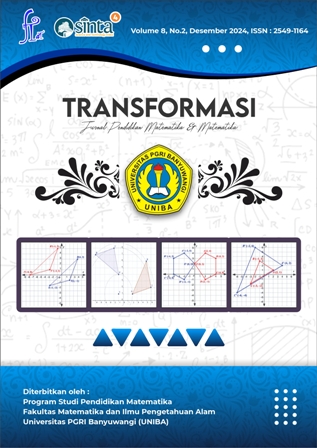MELEJITKAN SELF-CONCEPT PESERTA DIDIK MELALUI VIRTUAL REALITY (VR) DENGAN PROBLEM BASED LEARNING INVESTIGASI TEMPE
DOI:
https://doi.org/10.36526/tr.v8i2.4802Keywords:
Ecomath, self-concept, understanding concept, VR mediaAbstract
21st century education requires students to be able to develop various competenciew that not only include cognitive aspects, but also non-cognitive aspects such as attitudes, values and social skills. One inovative approach in developing assessment instruments is through the application of ecomath using Virtual Reality (VR) technology. Ecomath is packaged in market content presented in VR to stimulate students in learning mathematics. Problem based learning is used to boost students’ self-concept and problem solving abilities. This research is a qualitative descriptive study, which describes the results of implementing lesson study with the stages of plan, do, and see. The instruments used in this research were tests and observations. The research results showed an increase in self-concept and the ability to express between concepts by up to 21% in 2 cycles. Furthermore, VR can be used to stimulate students in learning economics with PjBL to increase insight and knowledge in meaningful learning.
References
Alpian, Y., Anggraeni, S. W., Mahpudin, M., & Priatin, S. (2020). Konsep Diri dengan Kepercayaan Diri Siswa Sekolah Dasar. Jurnal Elementaria Edukasia, 3(2). 379-383. http://dx.doi.org/10.31949/jee.v3i2.2532
Angelina, A., Ardimansyah, A., & Purnomo, S. R. (2023). Analisis Motivasi, Sikap, dan Konsep Diri Siswa terhadap Pembelajaran Matematika Kelas VA SD Negeri 40 Pontianak Utara. Fondatia, 7(2). 470-487. https://doi.org/10.36088/fondatia.v7i2.3469
Arikunto, S. (2018). Dasar-Dasar Evaluasi Pendidikan (Ed. 1). Jakarta: PT. Bumi Aksara.
Ayodele, O. J. (2011). Self-concept and Performance of Secondary School Students in Mathematics. Journal of Educational and Developmental Psychology, 1(1). 176-183. https://doi.org/10.5539/jedp.v1n1p176
Han, H., & Park, S. (2021). Virtual reality and augmented reality in education: A literature review and classification. Educational Technology Research and Development, 69, 1451–1479. https://doi.org/10.1007/s11423-021-09950-0
Indrawati, F. A., & Wardono. (2019). Pengaruh Self Efficacy terhadap Kemampuan Literasi Matematika dan Pembentukan Kemampuan 4C. Prisma: Prosiding Seminar Nasional Matematika, 2. 247-267. https://journal.unnes.ac.id/sju/prisma/article/view/29307/12926
Nopitasari, D. & Juandi, D. (2020). Persepsi Guru Terhadap Pembelajaran Berbasis Lingkungan. Teorema: Teori dan Riset Matematika, 5(2). 156-162. http://dx.doi.org/10.25157/teorema.v5i2.3307
Mahuda, I., Nasrullah, A., & Marlina, M. (2021). Konstribusi Self-Concept Matematis dan Kecemasan Matematika terhadap Kemampuan Literasi Matematika Mahasiswa. Wacana Akademika: Majalah Ilmu Kependidikan, 5(1). 51-61. https://doi.org/10.30738/wa.v5i1.9886
Manurung, A. S. (2020). Pengaruh Konsep Diri Terhadap Hasil Belajar Matematika Siswa Kelas IV SDN Kenari 07 Pagi Jakarta. Eduscience: Jurnal Ilmu Pendidikan, 5(2). 51-57. https://doi.org/10.47007/edu.v5i02.3102
Mohamed, R. A. K., Ali, A. H., & Nasir, M. (2021). Anderson & Krahthwohl Cognitive Application in Teaching and Learning Pantun in Elementary Schools. Journal of Humanities and Social Sciences (JHASS), 3(3). 110-118. https://doi.org/10.36079/lamintang.jhass-0303.286
Wahyuni, N. P., Agung, A. A. G., & Sulindawati, N. L. G. E. (2024). KAMI (Konsep Diri, Kompetensi Pedagogik, Motivasi Berprestasi, dan Iklim Sekolah) Meningkatkan Hasil Belajar Siswa. Jurnal Ilmiah Pendidikan Profesi Guru, 7(1). 60-74. https://doi.org/10.23887/jippg.v7i1.73453












